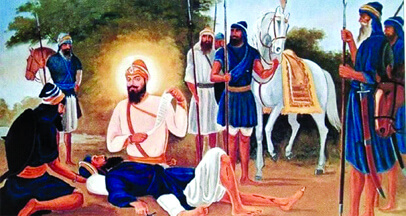
CHALI MUKTE, lit. forty (chalf) liberated ones (mukte), is how a band of 40 brave Sikhs who laid down their lives fighting near the dhab or lake of Khidrana, also called Isharsar, on 29 December 1705 against a Mughal force in chase of Guru Gobind Singh are remembered in Sikh history and daily in the Sikh ardas or supplicatory prayer offered individually or at gatherings at the end of all religious services. Guru Gobind Singh, who had watched the battle from a nearby mound praised the martyrs` valour and blessed them as Chali Mukte, the Forty Immortals. After them Khidrana became Muktsar the Pool of Liberation.
DARBARA SINGH, DlWAN (d. 1734), originally from the mercantile community of Sirhind, became a Sikh receiving the initiatory rites on 30 March 1699, the day the Khalsa was created, and took part in the battles of Anandpur. During the period after Banda Singh he commanded much esteem as a veteran fighter and as diwan, i.e. commissar in charge of rations and forage.
- 1
- 2








